The last time Shelbourne managed to finish a consecutive season in Ireland’s top-flight division was in 2012.
A decade of struggle ensued as the club blew through manager after manager, spending most of the time in the second tier with dwindling hope of becoming the dominant side in Irish football again.
Promotion back to the Premier Division ended up being nothing more than an ephemeral failure as the once-great titans of Ireland sunk back down to the gruelling wasteland of the First Division.
Ian Morris, who guided Shelbourne to promotion by winning the league in 2019, stayed on as the ship sunk. Shels won the First Division once more under Morris’ tutelage, but the former Bohemians player stood down from his post at the end of the campaign.
There were rumblings about who would replace the young coach. Within two weeks of his resignation, Shelbourne’s board decided to bring Damien Duff in as manager.
Duff, a two-time Premier League-winning player with Chelsea and a European finalist with Fulham, was the natural choice to replace Morris. The former winger had been managing the club’s U17s in what many say was an apprenticeship before eventually becoming the first-team boss.
Nonetheless, there were reservations about the appointment, namely that Duff had never managed a team in the men’s game before.
Nonetheless, by November 2022 when the season concluded, Duff had certainly proven his worth as a manager. Shelbourne finished seventh out of 10 in their return to the Premier Division and reached the final of the FAI Cup, losing to Derry City on the day.
Despite the cup final defeat, Duff had managed to achieve something that no other manager could over the past decade at Tolka Park with one of the youngest teams in the league. Shelbourne will now be playing in the top flight once more when the 2023 campaign kicks off.
Duff has shown immense potential as a manager and has also been touted to replace Stephen Kenny as Ireland boss in the future.
For these reasons, TFA have decided to include the former Chelsea man in our 23 for 23 series.
This will be a tactical analysis piece of Duff at Shelbourne. It will be an analysis of the preferred tactics that he has used in Dublin so far.
Formation and style
Style of play is far more important than any formation could possibly ever be. A team can use a 4-3-3 or a 3-5-2 or a 4-4-2 diamond, it really doesn’t matter, and tells little to nothing about how a team plays on the pitch.
For instance, at the FIFA World Cup, Morocco deployed a 4-3-3 in almost every game apart from the semi-final versus France. However, Walid Regragui’s idea of playing within a 4-3-3 is very different to that of Jurgen Klopp or Pep Guardiola.
So with that in mind, let’s take a look at a pizza chart which shows us how Shelbourne have played under Damien Duff so far.
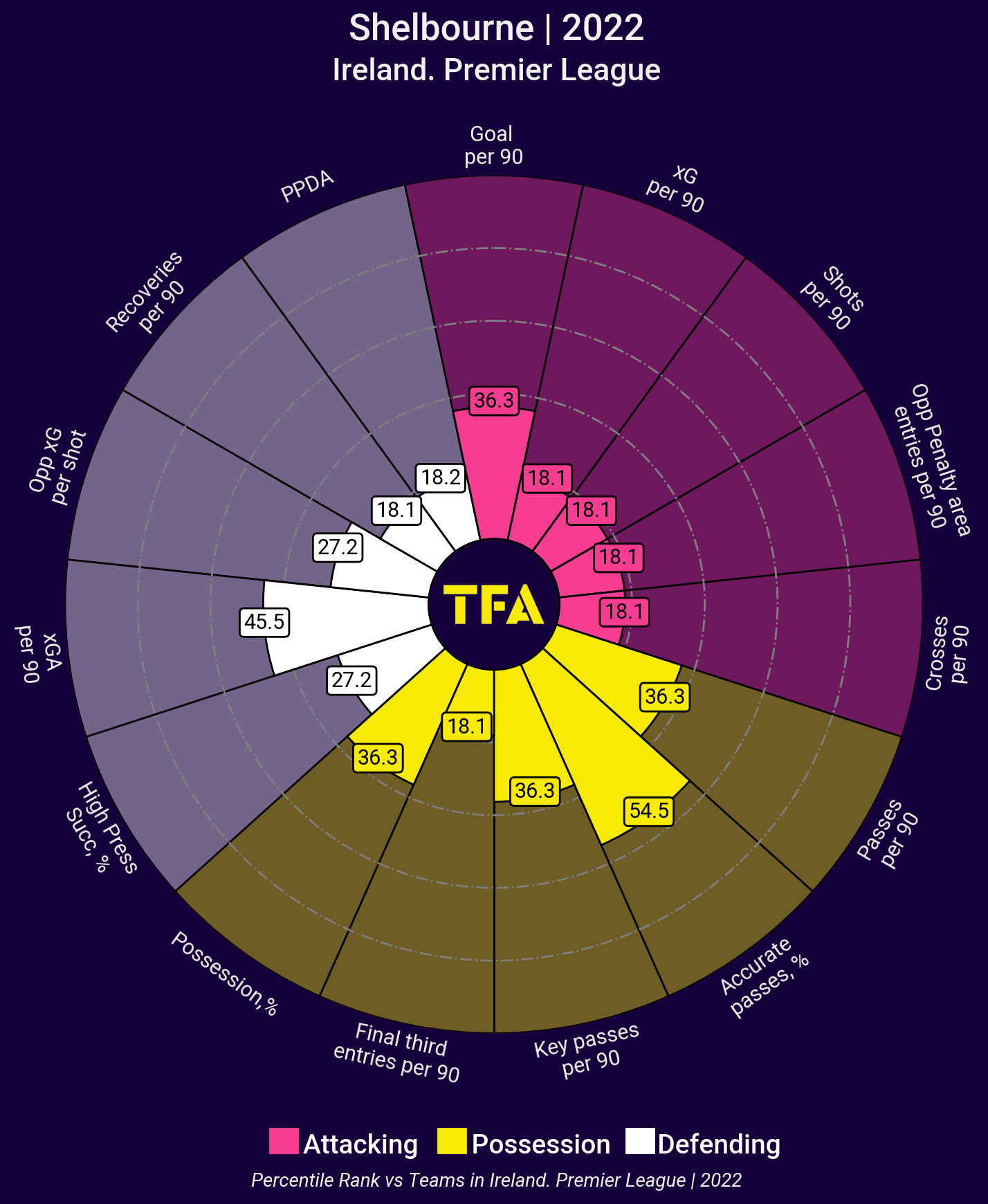
The reading from the data viz isn’t great. Accurate passes are the only metric where the Dublin club are over the league median, sitting in the 54th percentile.
Shelbourne are below the league average in every other stat. The team don’t score many goals, nor do they press high or hold the ball well.
Nonetheless, Shels are below the league’s average for goals conceded. This tells us one thing: Shelbourne are difficult to beat. Duff’s style of play over the past year has been focused on getting results and being tough to break down out of possession.
While this may mean the football isn’t glorious to watch at times, it can be effective and the Irish fallen giants have gotten some excellent results this season, notably the 3-0 win over rivals Bohs in the FAI Cup quarter-finals, a goalless draw over champions Shamrock Rovers and a 1-1 away tie versus second-placed Derry City up north.
Since taking over at Tolka Park, Duff has found peace with back-three formations. Shelbourne possess numerous central defenders and so it was sensible to rely on a solid defensive foundation first.
With players such as Shane Griffin, captain Luke Byrne, Kameron Ledwidge, Aaron O’Driscoll and the now departed Stephen Negru, Duff had centre-backs in abundance.
As such, it won’t be a surprise for many to see that Shelbourne’s most utilised formations under Duff have been the 5-3-2 and the 5-4-1 which the manager has fluctuated between over the past year.
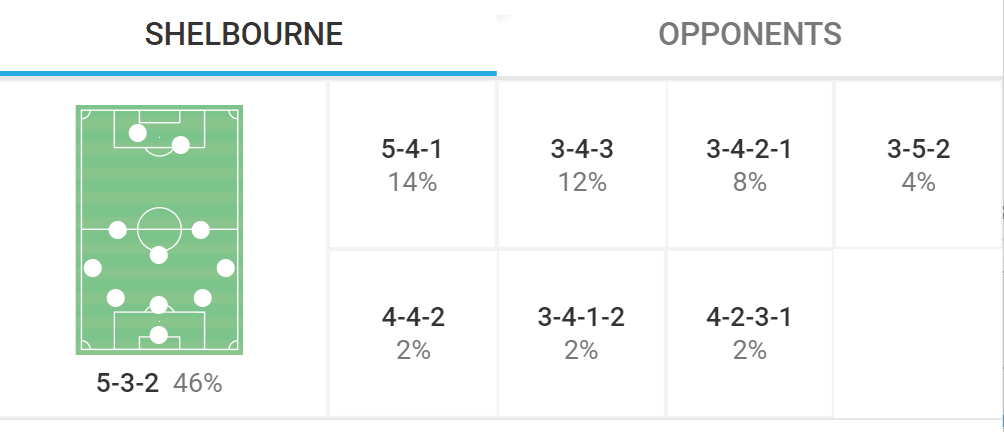
Being tough to beat was the main concern for Duff last season before any attacking patterns were created which is why Shelbourne used such conservative shapes at times.
So now that Duff’s style of play and preferred formations have been identified, let’s take a look at the manager’s tactics in his first season in the men’s game.
Defensive setup
Looking at the rest of the league’s defensive stats, it’s not a coincidence that Shelbourne finished seventh last season.
The Drumcondra-based club scored the fourth-fewest goals, conceded the fourth-most goals and ended the campaign fourth from bottom. The three teams that finished behind Shelbourne in the table all boasted fewer goals and more conceded, so it all aligned perfectly.
It was Shels’ ability to concede fewer goals than their relegation counterparts which kept them in the top flight for another season and Duff’s pragmatic mind played a massive part in this.
The football certainly wasn’t conventionally beautiful at times — although beauty is subjective — but it got the job done.
Duff hasn’t been so keen for his team to press high up the pitch as the season progressed. In his very first competitive match in charge against St. Pats, Shelbourne were prepared to press in the final third, but this was bypassed easily.
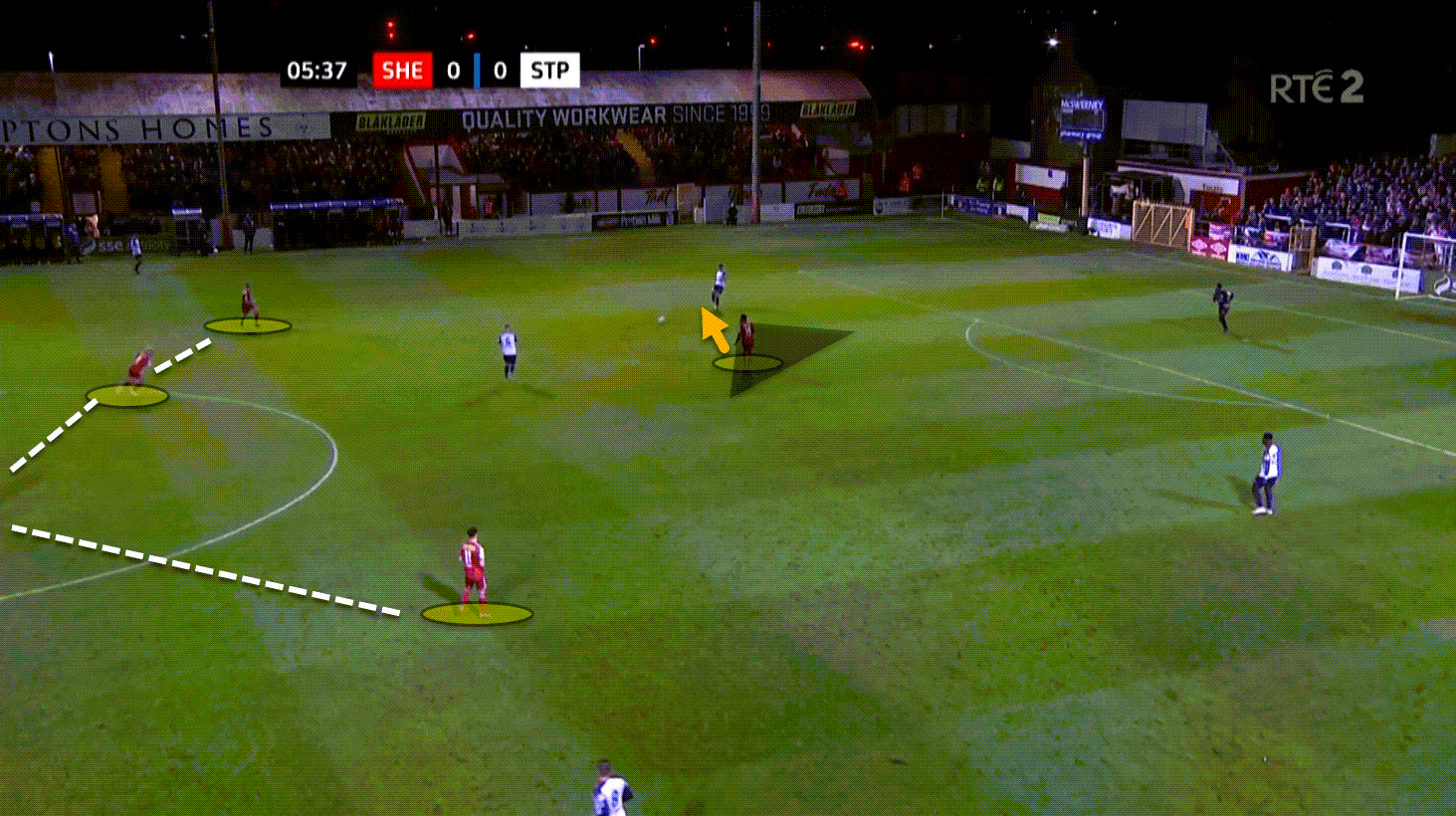
The reason for this was that the Dublin giants were using one striker up front. This isn’t necessarily an issue when pressing but the frontman needs to be supported by either his wingers or else one of the central midfielders.
The striker was left isolated, and it was quite easy for St. Pats to play around the striker’s pressure into the pivot player.
Again, the press broke down as Shelbourne’s double-pivot were constantly late when stepping up to put their opposite number under pressure and so the player could simply turn and play forward.
Not pressing high isn’t a problem but if a team are going to defend in a high block, they must commit with numbers.
In the end, Duff decided he would prefer if his players sat off in a more compact mid-block which is not as risky as pressing when the opposition is building up play.
Shelbourne stay compact between the lines and look to force their opponents to play to the outside.
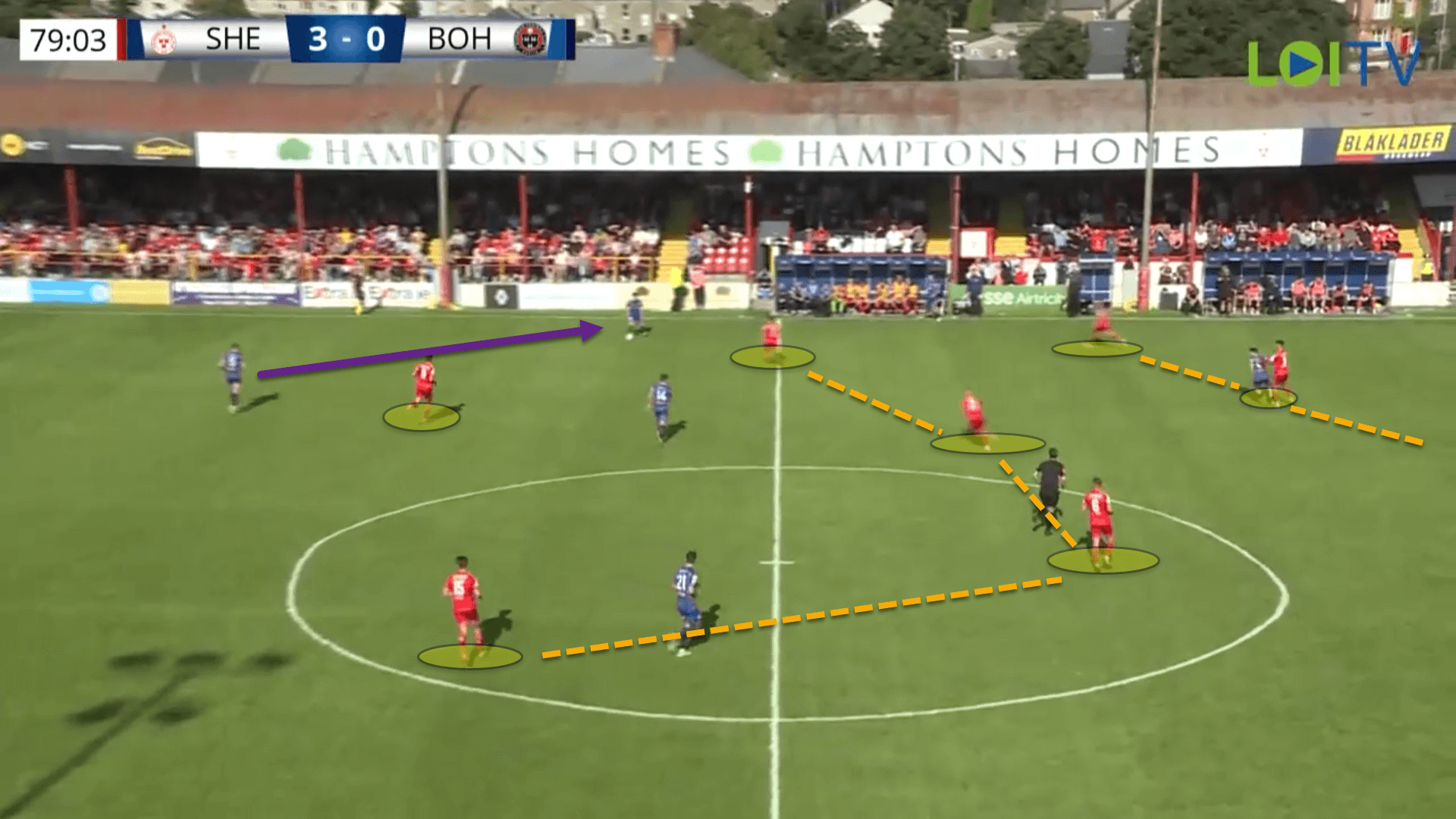
In this example, Duff’s side are defending in a solidly structured 5-4-1 in the middle third against bitter rivals Bohs. The ball has been passed to the left flank by the attacking side.
Once this happens, the players must push across as a unit while picking up the nearest passing options for the opposition. This is done in quite an aggressive manner with the aim of winning the ball in this wide-pressing trap.
Defending in this manner for Shelbourne has primarily worked for the side when Duff has gone with a 5-4-1 as the team can double up on the flanks using the wingers and wing-backs in cahoots.
What has been less functional is the adoption of this more aggressive wide defending when Shelbourne have defended in a 5-3-2 block. In this shape, the nearest central midfielder must push across.
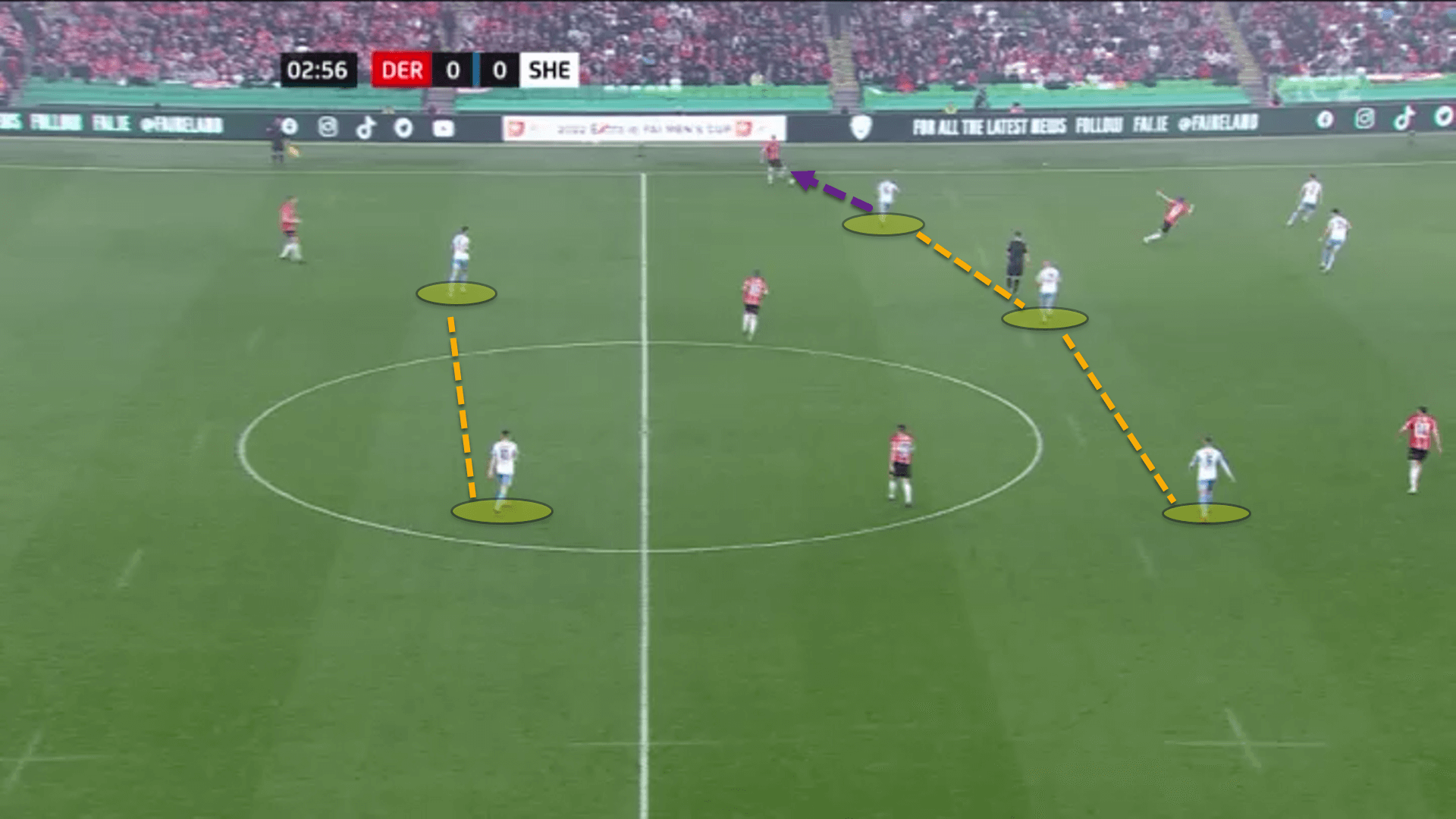
Unfortunately, Duff set his side up to defend this way in the FAI Cup final which went horribly wrong for Shelbourne.
Derry were constantly playing wide to entice the midfielders to push across before pushing it back inside and looking to progress between the lines of an exposed core.
It wasn’t the only mistake made by Duff in the final, but the manager has shown an ability to react to problems and look to rectify them quickly.
For instance, within the 5-3-2, the former Celtic first-team coach chose youngster Shane Farrell at left wing-back. Farrell is a wonderfully versatile player and is astute both offensively and defensively.
However, the 22-year-old tends to ball-watch and can lose his man when the opposition player is on his blindside. Derry knew this and so attempted to play some quick switches of play over his shoulder. On one occasion, the attacker got the better of Farrell at the far post who was caught sleeping and the eventual winners opened the scoring which was also the winning goal too.
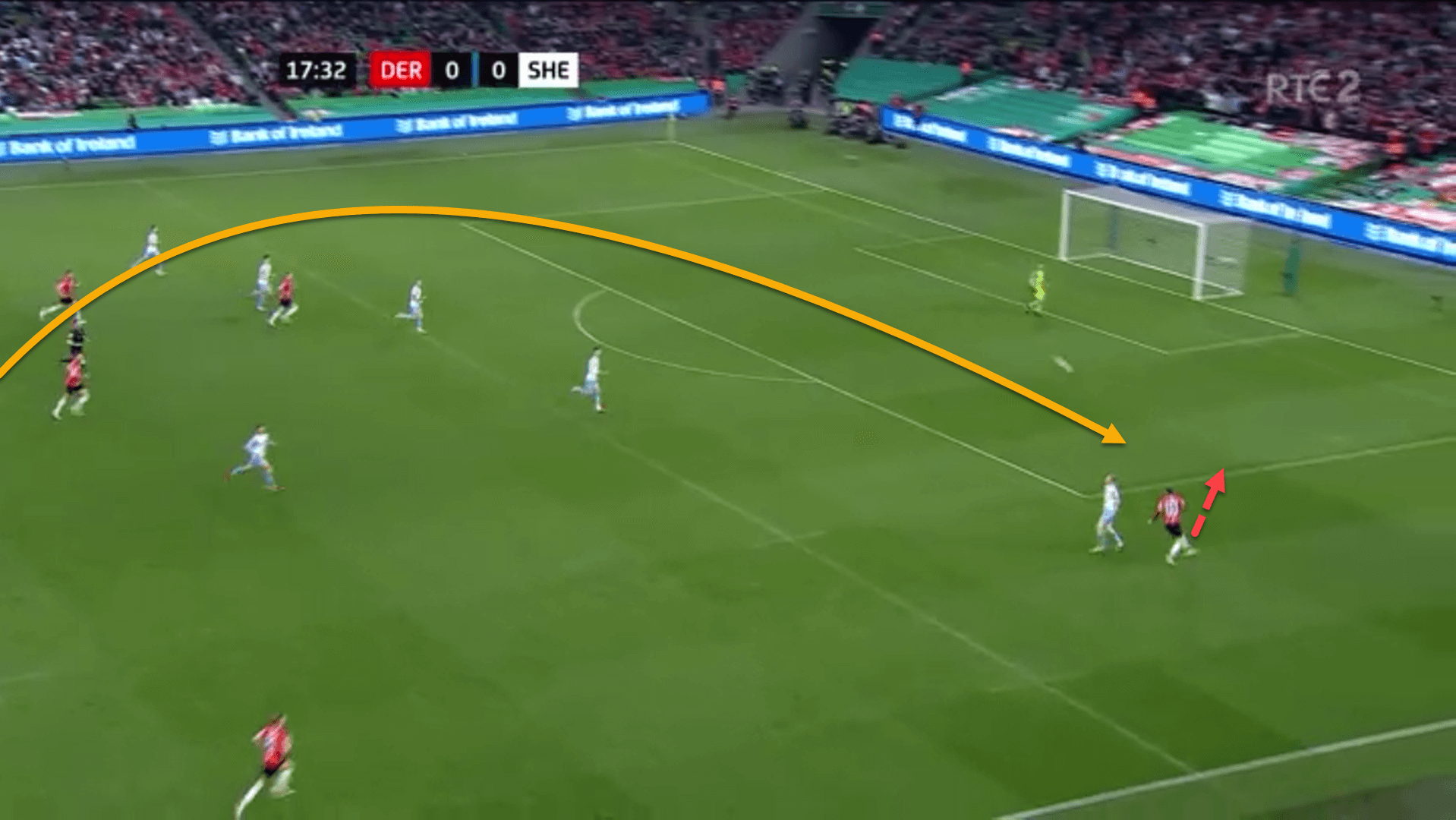
Nonetheless, just a few minutes after, Duff attempted to fix the problem, putting midfielder Gavin Molloy out left as a wing-back and placing Farrell into the middle of the park.
Derry went on to win 4-0 in the end, but the change wasn’t necessarily correlated. It was still quick thinking from the man that fans have labelled ‘Duffer’.
Lower down the pitch is where Shelbourne have been more difficult to carve open. Once the Reds’ mid-block has been beaten, they look to delay their opponents and form a solid low block with plenty of wide coverage but also ensuring that space between the lines is sealed off.
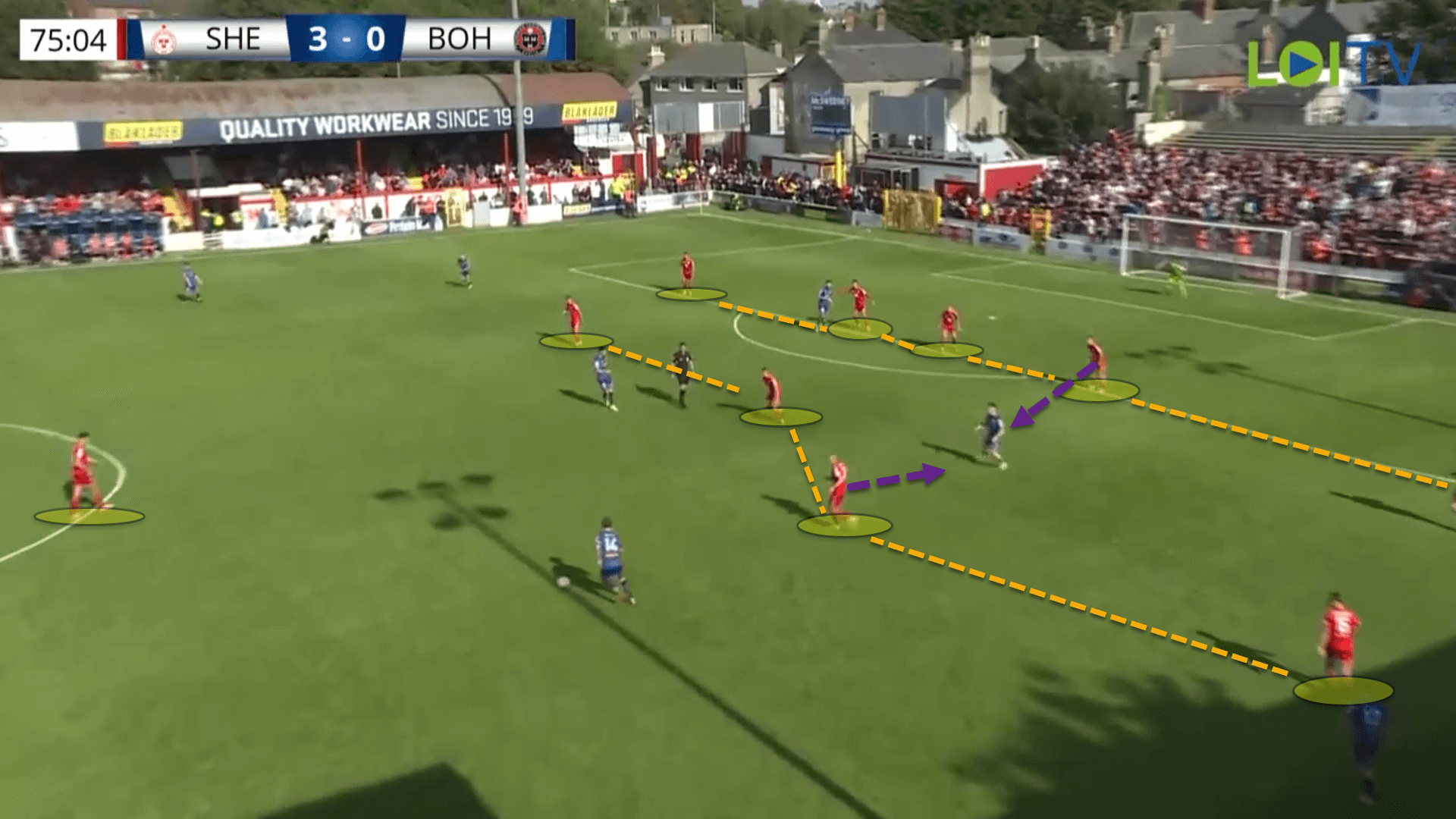
The central midfield players cut off passing lanes into this space, but Duff demands that the centre-backs be ready to step up and be aggressive in case a ball is played into this area.
Shelbourne’s low block has looked quite formidable at times, particularly on home soil as Tolka Park is quite a small pitch in terms of length but also width, so it may look as though there is no space to play forward into at times.
In the 2022 Premier Division, out of ten teams, Shelbourne finished as the fifth-lowest ranked side for expected goals against — excellent for a newly-promoted team.
The Reds registered an xGA of 40.73. Only Bohemians, Dundalk, Shamrock Rovers and Derry had less. Duff’s defensive game plans were painful to watch at times but his dogmatic methods paid dividends as Shelbourne prepare for life in the top flight once more.
In possession
Under Duff, Shelbourne have taken a practical approach to their attacking play. While the manager may eventually want to play a more possession-based approach, or what many would typically classify as a ‘modern’ style of play, limitations within the squad have hindered this.
Duff needs to be realistic with how he wants his Shelbourne to play, although, to his credit, the Reds do attempt to play out from the back at times.
In this phase, the side create a 3-2 build-up shape. The five players stay really close together to offer short passing options to one another.
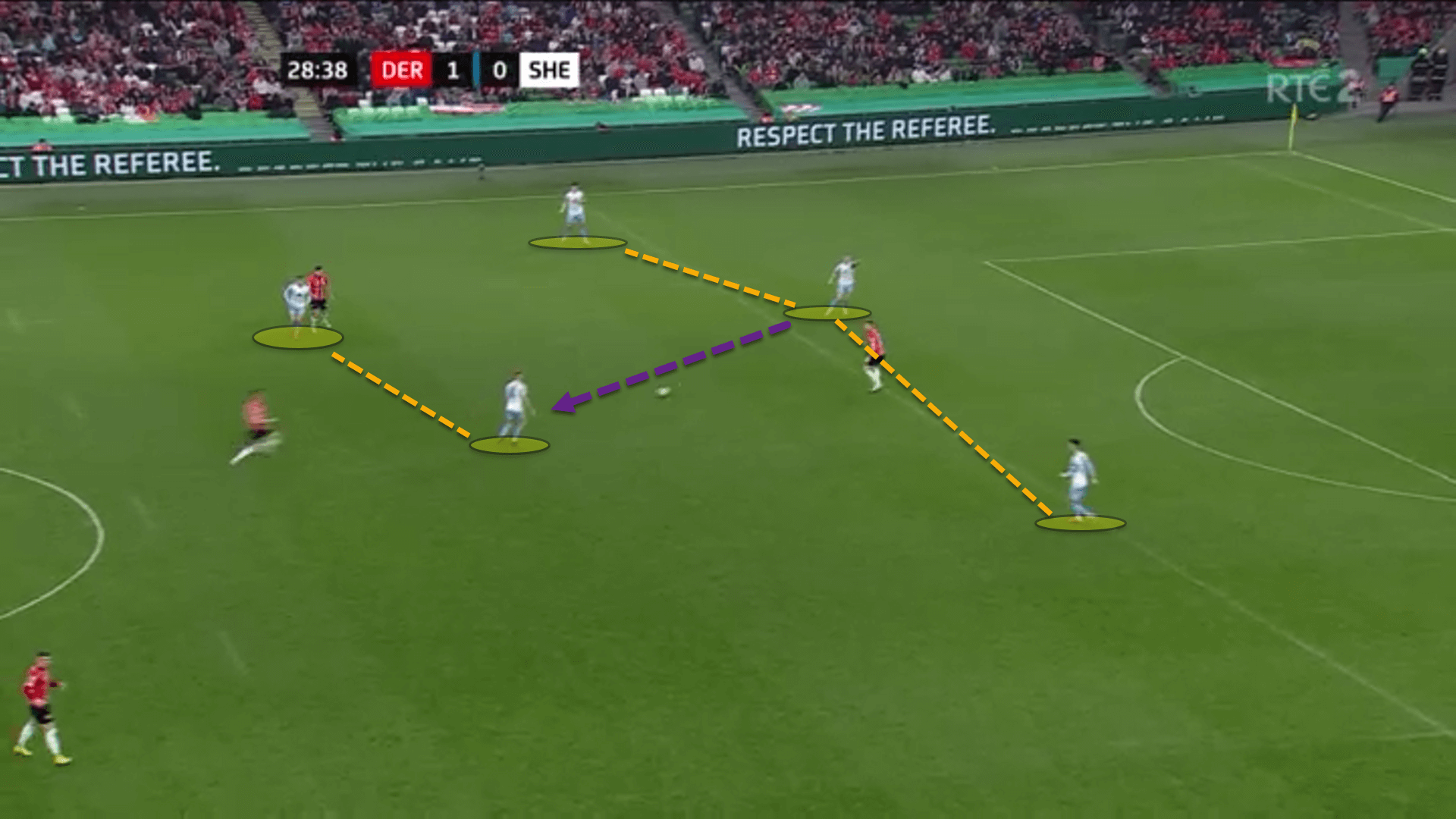
This approach is quite similar to the one adopted by Brighton and Hove Albion ever since Roberto De Zerbi took charge at the AMEX.
The objective is to make secured, short passes to entice the opposition to jump forward and press, leaving space in behind. The passing needs to be done quickly and accurately.
Quite often, when teams used a back three to play out from defence, the three centre-backs split wide to cover the width of the pitch. However, the passing distance is larger and gives way to more untidy passes and poor ball control.
Keeping the distances short means that players have more control of the ball and can find each other better. It also has defensive benefits too as, if the ball is turned over, the five players are already at a close enough distance to recover possession, forming a solid rest defence base.
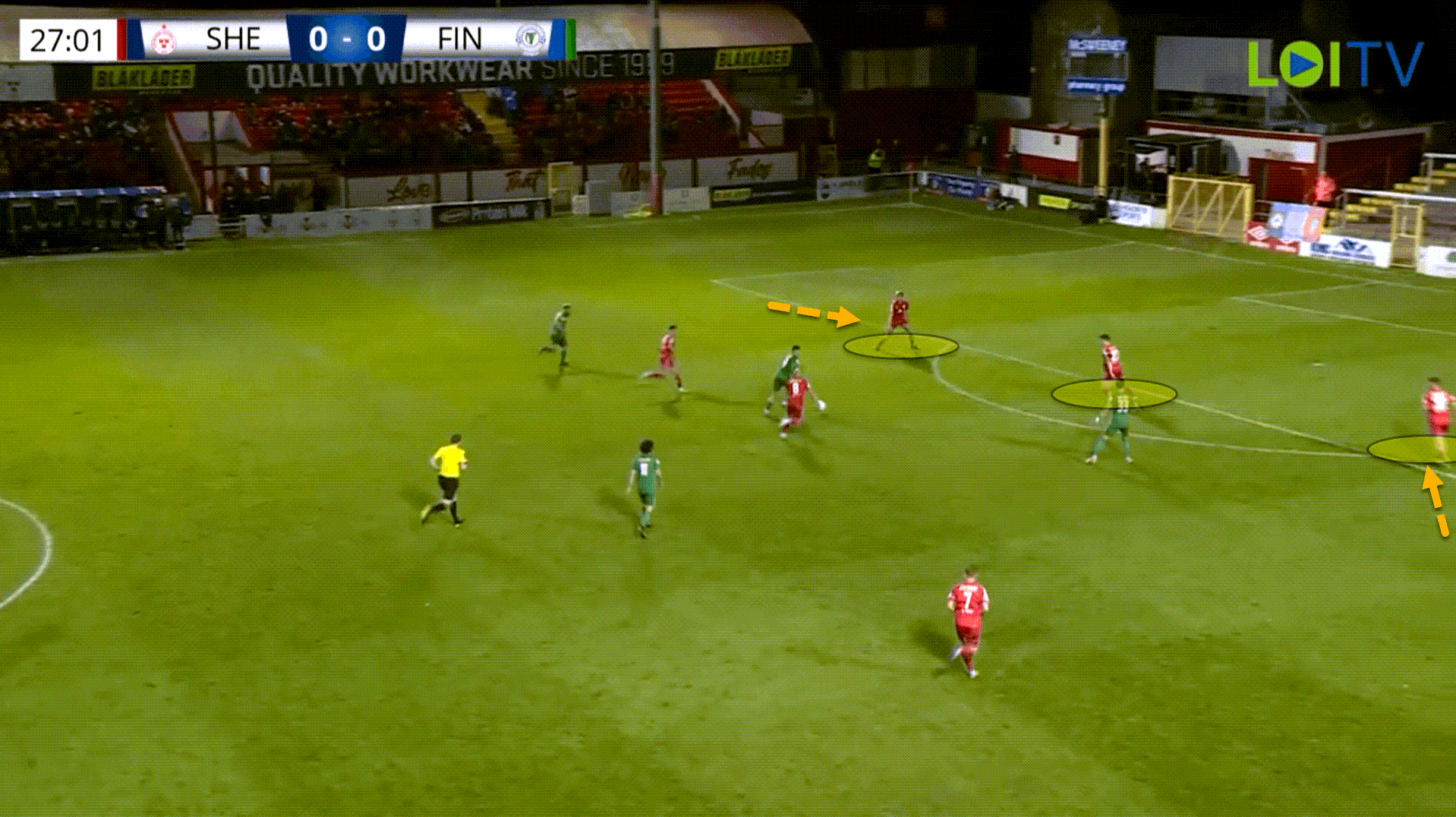
For instance, here, a mistake when playing out from deep caused Finn Harps to collect the ball in a dangerous position. Thankfully though, Shelbourne’s three centre-backs and double-pivot were already at a close distance to recover the ball quickly and avert the danger.
First and foremost, Duff wants his players in the build-up to try and entice the opposition to jump forward to reach his attacking players between the lines.
This is particularly evident when Shelbourne set up in a 5-4-1 which becomes a 3-4-2-1 in attack. The two wingers act as central playmakers, similar to how Chelsea operated during Thomas Tuchel’s UEFA Champions League winning campaign.
Duff has primarily used Jack Moylan and Matty Smith in these positions. The duo are excellent in front of goal but are deadly between the lines, creating chances for others.
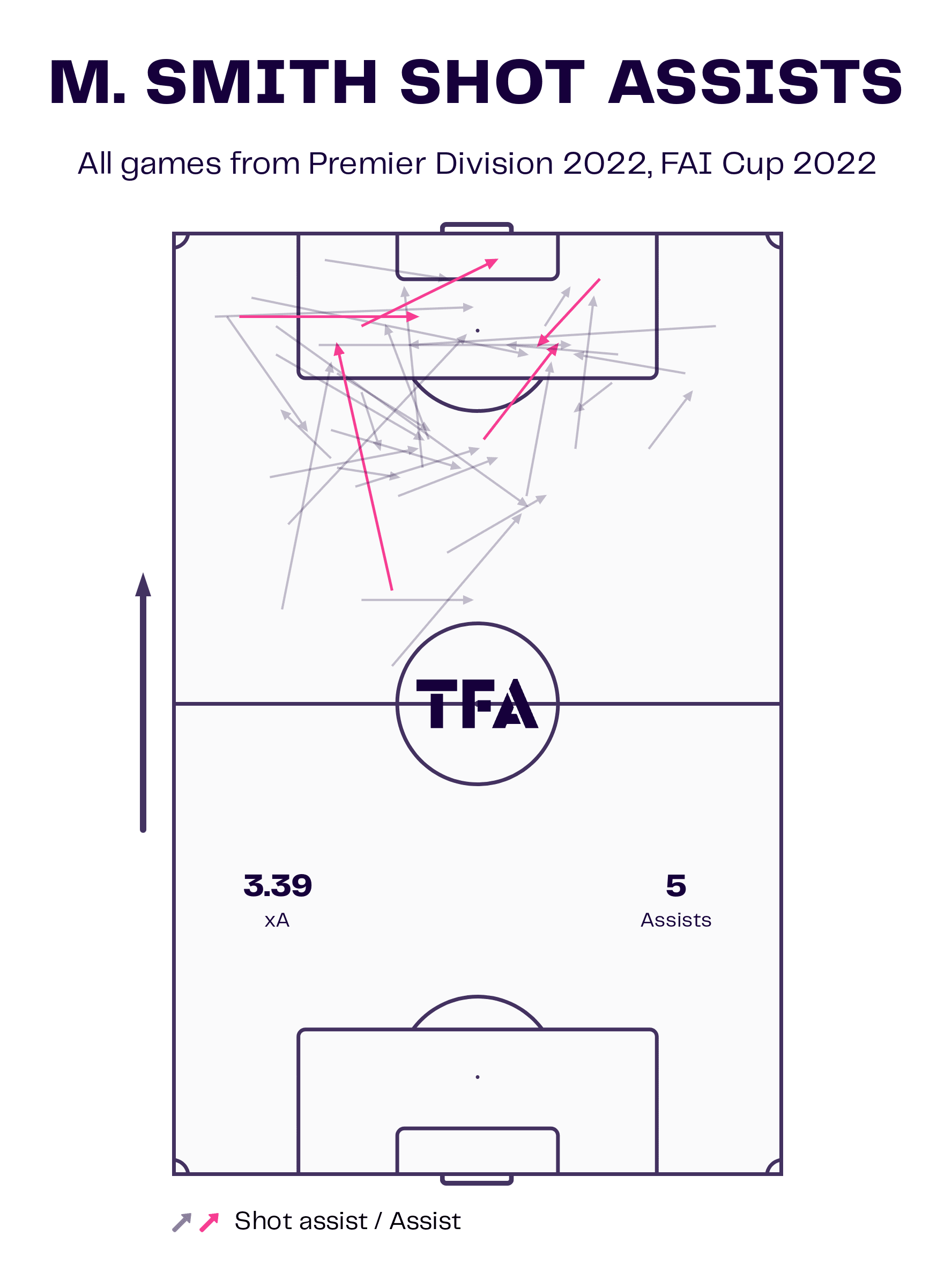
Smith, in particular, was a menace around the 18-yard box, putting his teammates into excellent goalscoring opportunities.
The use of the double playmaking wingers along with a narrow build-up base has worked really well for Shelbourne under Duff so far and was a wonderful tactical idea that the former League of Ireland player brought to Tolka Park when he took over more than a year ago.
Nonetheless, things aren’t always rosy in the garden. Shelbourne don’t possess the correct technical players to consistently play this way during games.
Often, the space between the lines is blocked out and so reaching Smith or Moylan is difficult. The side must have another way of playing in order to answer any questions posed by their opponents.
This other method is to go in behind or else play long to the centre-forward. Sean Boyd has led the line for the majority of the season. The 24-year-old stands at around 6’4”, or 195cm, and is a gargantuan presence up front.
A lot of the time, the tactics from Duff are quite simple — go long to Boyd and win the second ball.
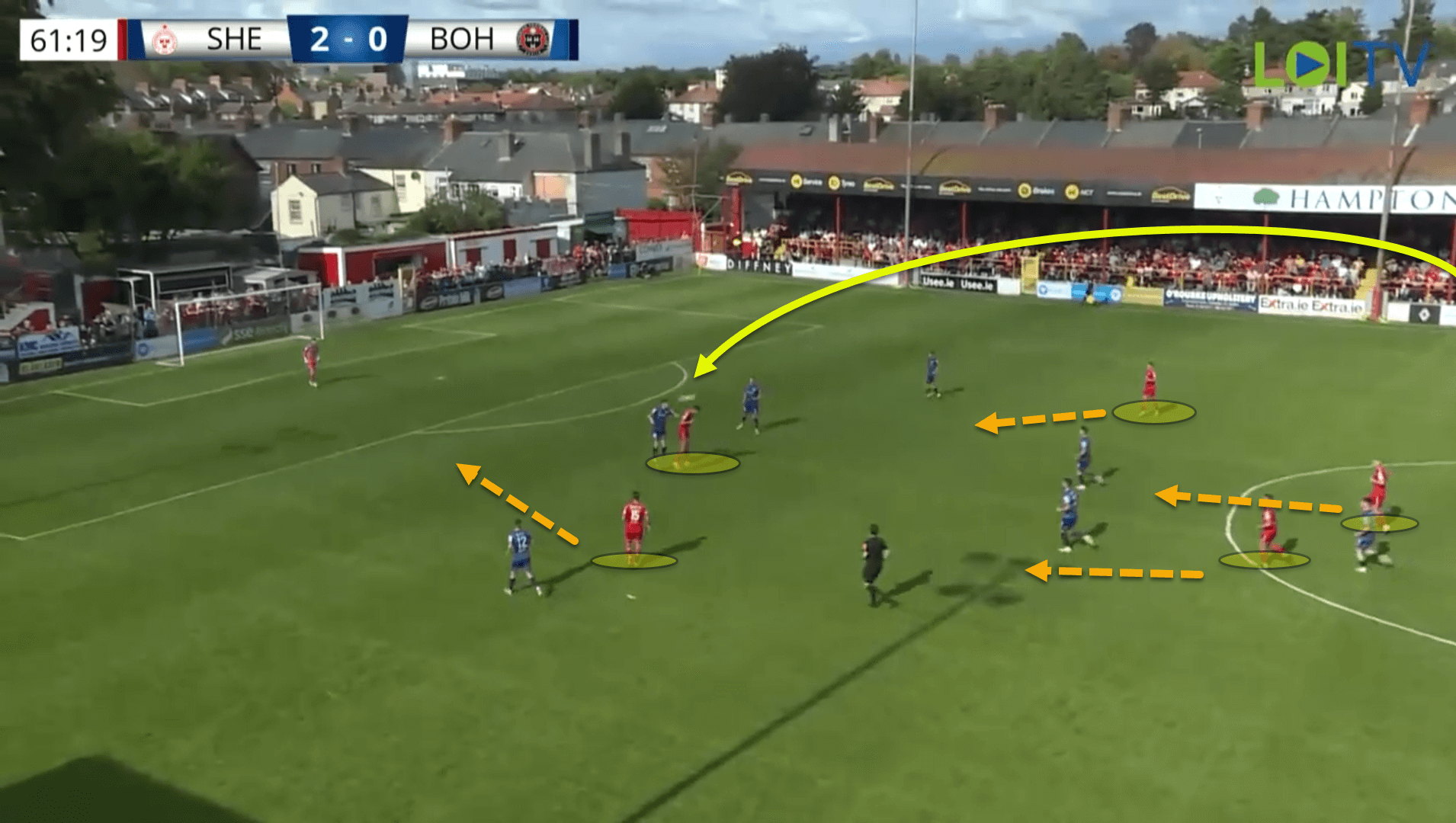
The players are tasked with supporting Boyd both in front and in behind, allowing the side to win the second ball if it’s either flicked on into space or knocked down.
On other occasions, Shelbourne will use their solid build-up base to entice the opposition to jump when pressing so as to play in behind to runners, particularly the wing-backs who are constantly getting high and wide to attack the depth.
JR Wilson on the right and Farrell on the left have performed these roles really well for Duff. The wing-backs provide the width for the team in what is largely a narrow structure in possession while their runs in behind help to stretch the opposition’s block vertically, creating space between the lines for Moylan and Smith.
If Shelbourne can play neat passes among the centre-backs and the double-pivot to lure their opponents higher before hitting it into the channels for the wing-backs, they will absolutely take this route.
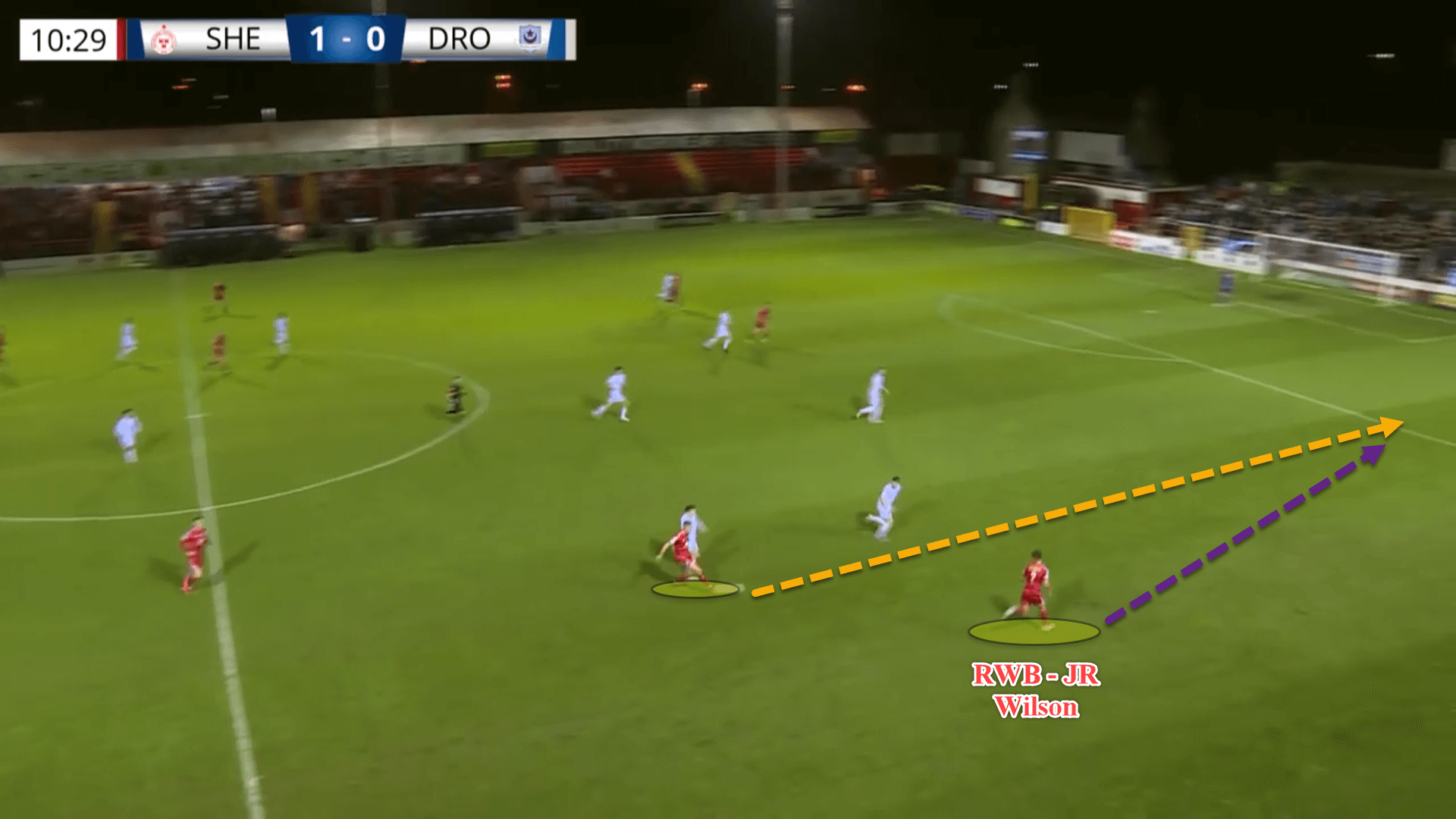
In and around the box, Smith and Moylan are of vital importance when breaking down a low defensive block to create goalscoring opportunities.
The duo are always linking up with one another as well as with Boyd up top to try and find space among the opponent’s centre-backs to break the lines of the defensive side.
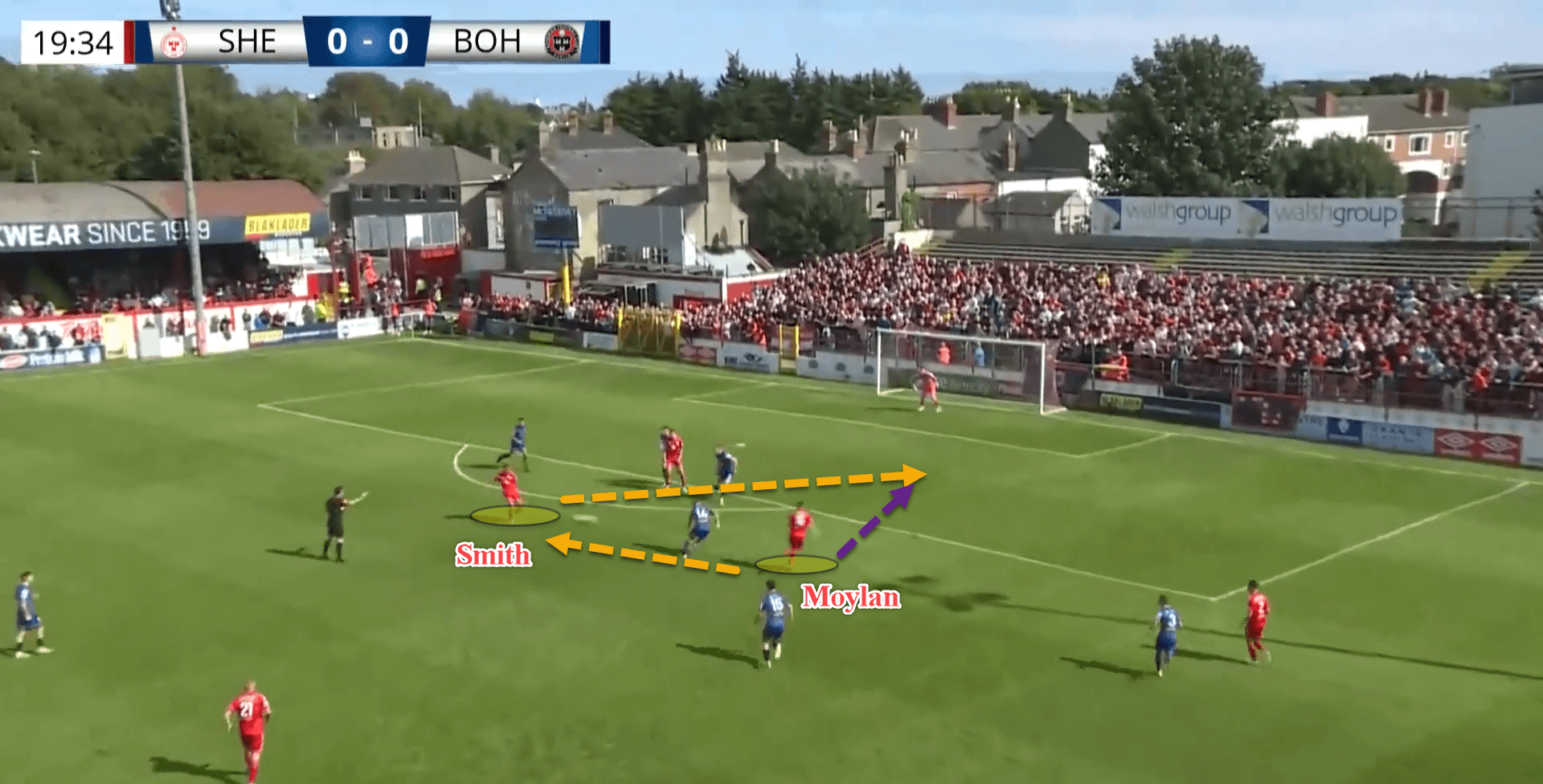
However, this isn’t always possible. Again, a lot of the time, the opposition will have blocked off access to this threatening zone, more commonly known as Zone 14 in the coaching world.
If Smith and Moylan can’t receive between the lines and create chances, the objective from Shelbourne is simple and normally effective — go wide and cross to Boyd.
Boyd is a handful for any defender and is superb with his head but also with his feet. Providing the cross is accurate, balls into the penalty area for Boyd are certainly an effective tool that Duff has utilised this season.
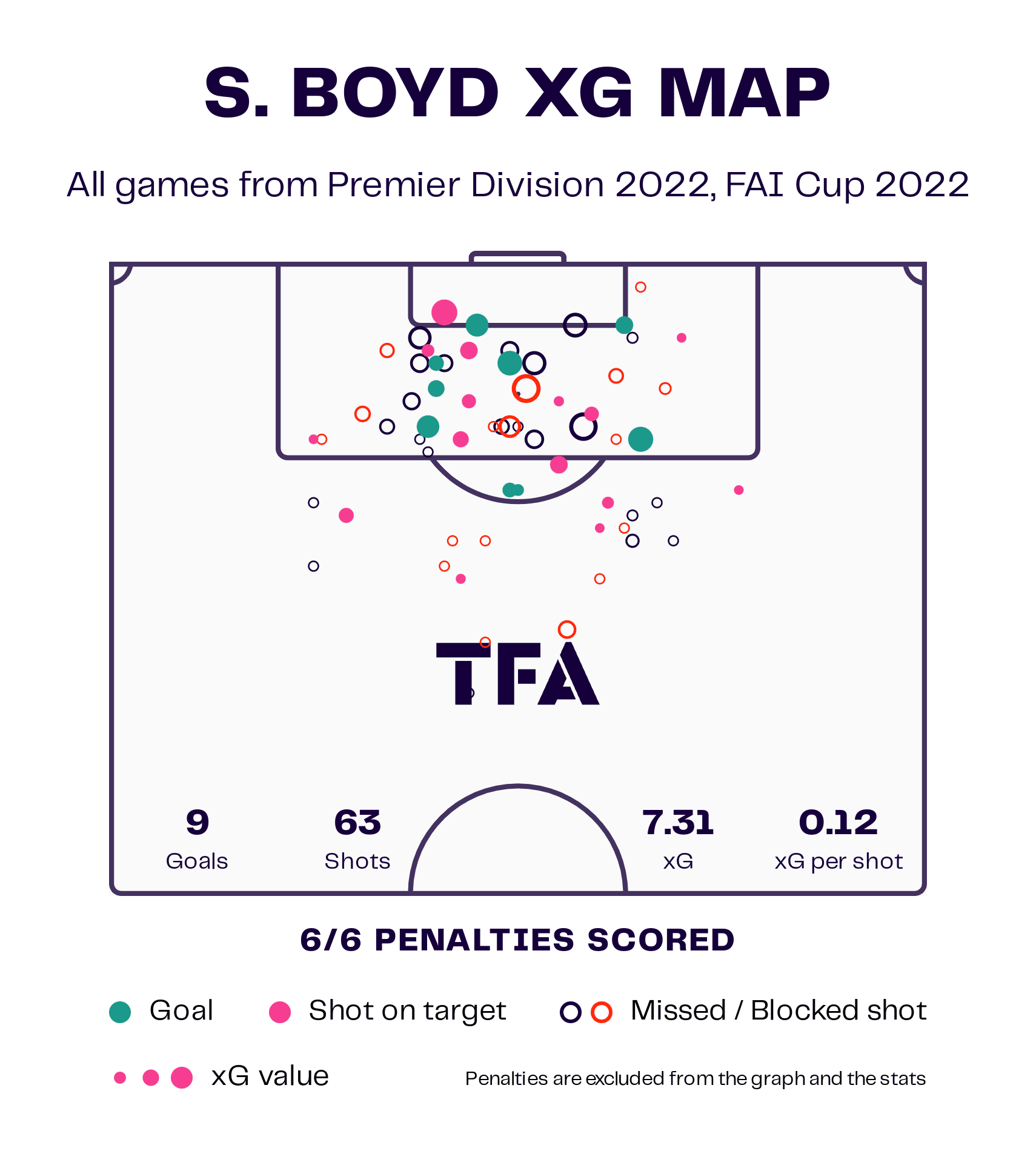
Boyd has been a menace in the box, scoring nine non-penalty goals in all competitions for Shelbourne since Duff’s arrival which coincided with the target man signing for the Dublin club.
As always, Duff has been realistic about Shelbourne’s attacking play. It can’t always be pretty, but the intention is to play to the strengths of the players within the ranks rather than forcing them to bend to a style that doesn’t suit them.
Conclusion
It’s difficult to predict who the next top managers will be. Of course, it’s a lottery, especially considering how quickly things change in football.
However, Shelbourne are on an upward trajectory, giving supporters at Tolka Park hope that the club will be somewhat restored to the titan it once was in the Republic of Ireland and Damien Duff certainly looks like the right man to lead the revival.






Comments